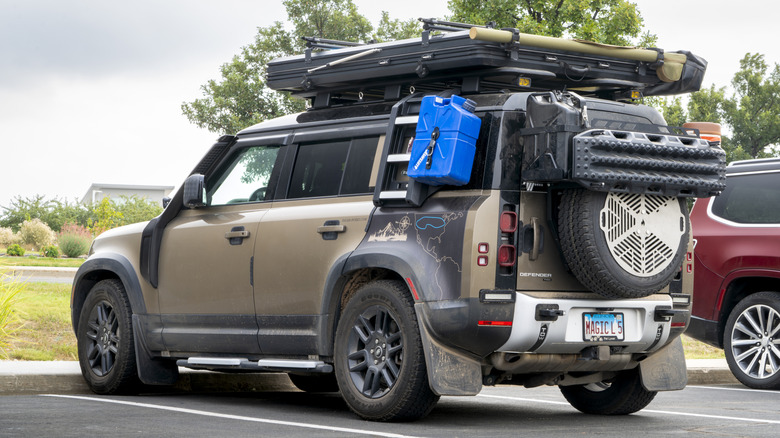How Much Roof Weight Can Your SUV Hold? Here's How To Find Out
If you've ever packed for a long weekend with family, friends, or a dog, there's never enough cargo space. Whether it's for kayaks, skis, bikes, or even just weekly shopping, eventually, you realize you need to start packing the roof box. However, just like with towing capacity, your roof has a limit too, and understanding it isn't as straightforward as it may sound. So, how much roof weight can your SUV hold?
First of all, driving exerts up to five times more stress on a vehicle's chassis with extra weight on the roof, which is why a car's roof has two different types of weight limits. A dynamic limit refers to the maximum weight you can carry on your SUV's roof while on the move. A static limit — something you need to consider when buying a car rooftop tent – is the maximum weight the roof can support when the vehicle is parked.
Regardless of whether it's static or dynamic weight, for the exact limits, always check your owner's manual first. It's the only truly reliable source of information specific to your vehicle's trim, options, and limitations. It's also worth noting that going above these limits is dangerous. Besides greatly straining your SUV, it can also compromise stability, safety, and comfort. This is why you should know your limits before you start packing.
Understanding roof weight and safe loading for SUVs
There are many reasons why you should read your owner's manual, and finding out your car's load capacities is just one of them. An SUV's roof weight limit is typically listed under sections titled "Roof Load Rating", "Load Carrying", or "Carrying Cargo." If you are not able to find any information within the owner's manual, try searching for a sticker or a placard on the inside of the door jambs or directly on factory-installed roof rails.
If you can't find anything within the manual or the car itself, it's also a good idea to call your dealer and provide the VIN. Alternatively, there are many online sources you can check, namely forums, manufacturer websites, and car specification databases. Sites such as Car.info can provide valuable load capacity data on most cars, just make sure to enter your car's make and model into the search box.
Either way, only use these as substitutes, as they are not official specification databases, and they may not take into account panoramic sunroofs or different roof rails. It's also important to note that roof racks have their own weight limits as well, and sometimes they can be lower than the roof of the vehicle itself. In that case, always follow the lower of the two. Lastly, pay attention to your total payload.
Driving an SUV with a roof rack
According to an efficiency study carried out by the U.S. Department of Energy, roof racks, on average, increase aerodynamic drag by 20%. If we pair this with the added weight on the very top of the vehicle, your stability and fuel efficiency are going to be strained. Heavy loads can affect your tires, so make sure to check your tire load index and whether they are able to carry all the added weight, regardless of the roof limit.
If your rack is particularly tall, or if you drive a lifted SUV, also pay great attention to height clearances, as some garages, carports, or drive-through areas might be tight. It's crucial to properly secure your load and to check your clamps and straps as you go, as those can loosen while driving. Strong crosswinds might push against your roof racks while snow and ice might even settle and thus increase the weight on top of your roof even further.
Before setting off, always do your best to properly distribute the weight across the entirety of the roof. It's also important to note that off-roading exerts additional forces onto the chassis, which is why you should lower your maximum roof load accordingly. Lowering it by about 33% for most roof racks, or by about 50% for a clamp mounted roof rack is a good rule of thumb to follow.


